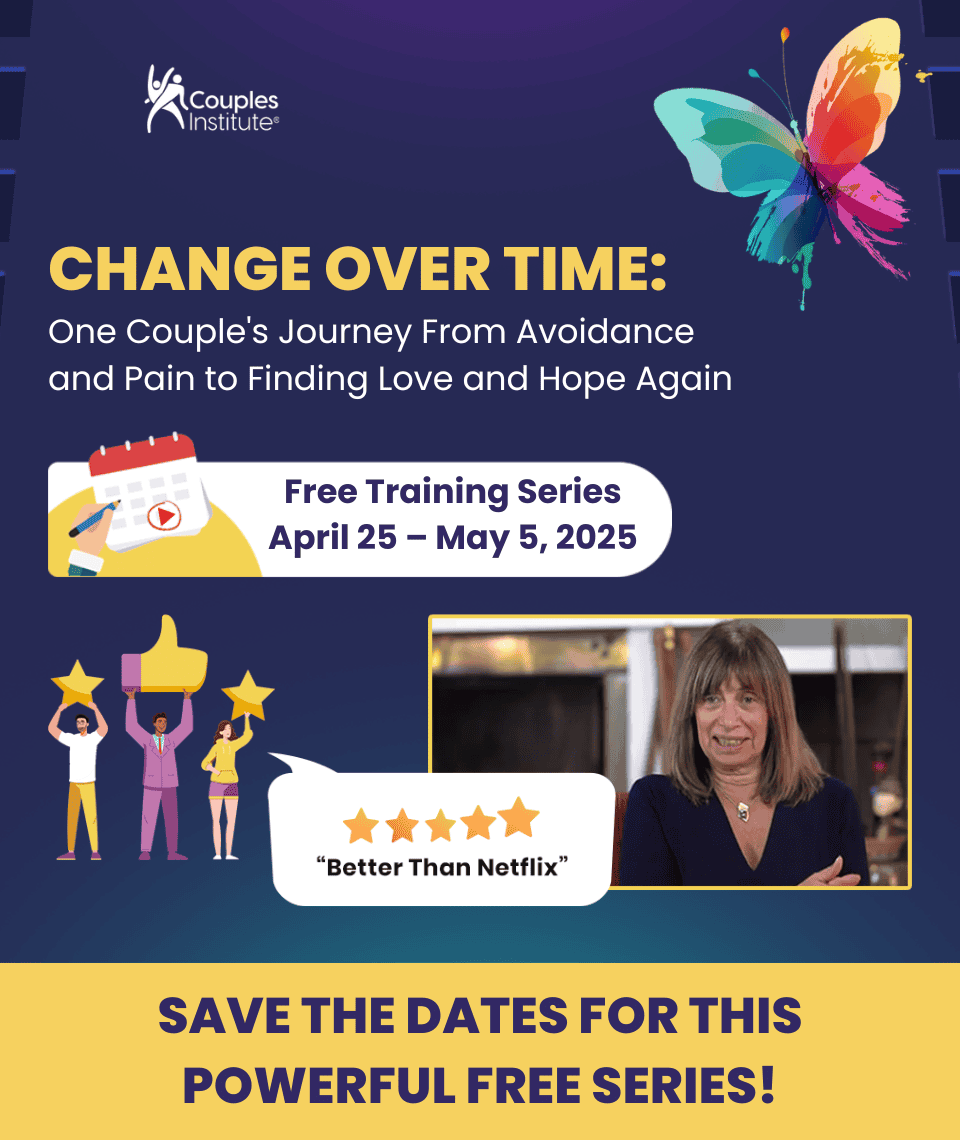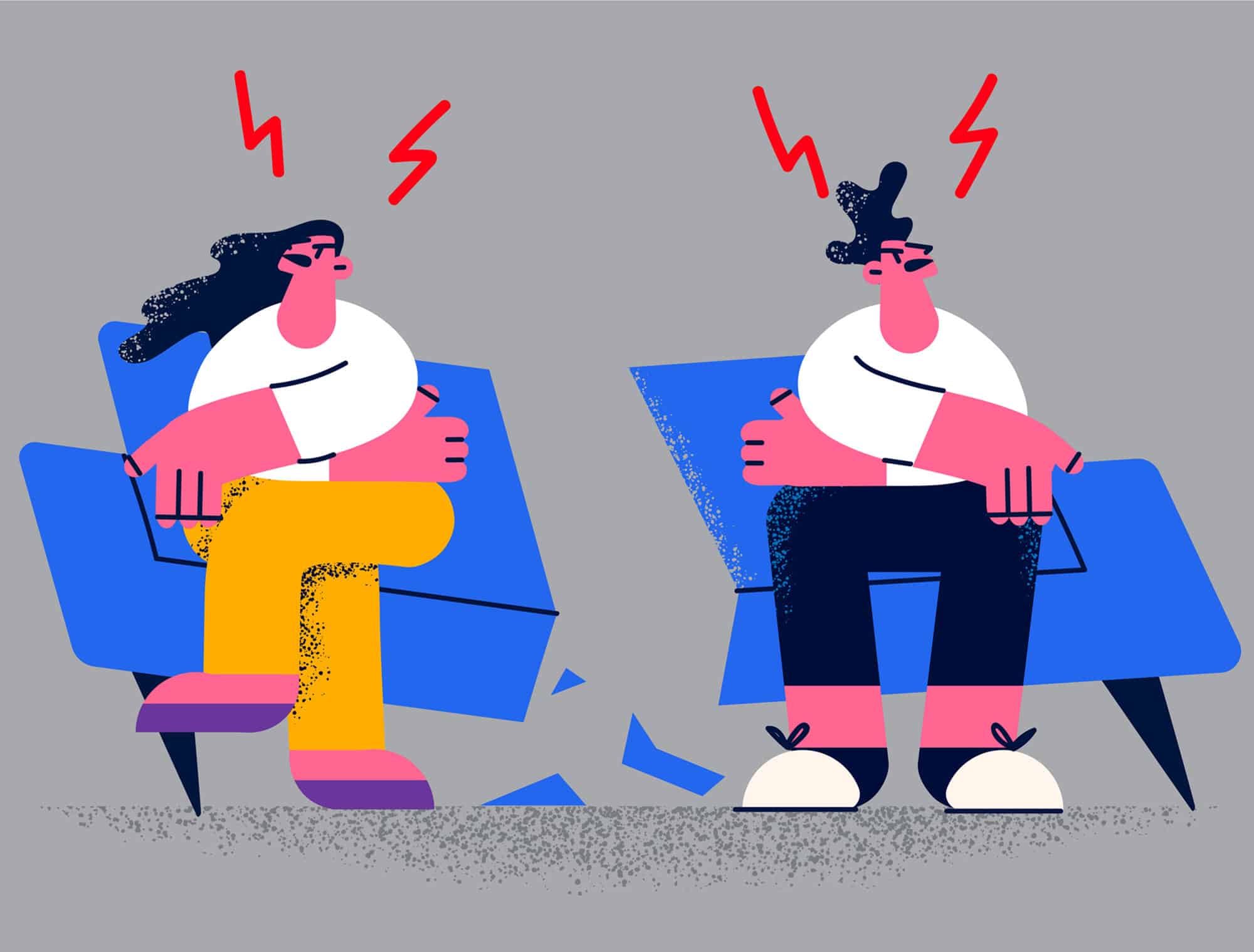When a couple with a long-term conflict-avoidant history comes to see you, change is often excruciatingly slow. You may wonder, “Am I being effective?”
Here is why these couples are challenging:
- Many partners wait for their spouses to take the active role, while they remain passive or inactive themselves.
- These partners usually want better relationships but have deep fears and avoid taking the risk to be authentic.
- They will “collapse” quickly rather than risking truthfully expressing their desires.
- They test you and then test each other to be sure they will survive the stress of disagreement, conflict, or differentiation. As a result, they are slow to bring up much substance in therapy.
So how do you work with conflict avoidant partners?
Here is a step-by-step summary of what it takes to create substantial change in long-term conflict-avoidant relationships.
- Describe their avoidant pattern and demonstrate how the choice of avoiding conflict is self-protective, yet keeps them stuck and disengaged.
- Confront their growth-inhibiting beliefs and passive behaviors when they occur in your sessions. You must actively challenge these!
- Ask each partner what will help them tolerate more emotional intensity.
- Establish some risk-taking goals for each partner.
- Highlight the importance of tolerating tension. Explain to them that staying with a substantial issue from beginning to end instead of disengaging from it will challenge them, but it will also be the pathway to enormous progress.
- Create intensity in sessions, while providing developmental assists to each partner that encourage and support their evolution.
I enjoy seeing comments from readers. Please use the comment link to describe your thoughts about these ideas. Better yet, try one or two of them in your practice and let us know about your experience.
If you’ve ever sat across from a passive, avoidant couple and wondered, “Am I even helping?” you’re not alone. And more importantly, you don’t have to figure it out alone.
We’re taking you behind the scenes in a powerful new series that follows a real couple with a 10-year history of flatness, avoidance, and emotional shutdown. You’ll see exactly how to break through the fog of vagueness, reignite connection, and create movement with the couples who are disengaged and intimacy avoidant. You’ll see the couple change and their therapist grow in her capacity to facilitate interventions and make developmental assists that open both partners to one another again.
One unforgettable case over time. You’ll see insight, real progress, and practical interventions you can use immediately.
Mark your calendar for Change Over Time: One Couple's Journey From Avoidance and Pain to Finding Love and Hope Again.
Here’s the LIVE Webinar Schedule for the Free Series:
1. Stuck in Vagueness and Passivity: Turning Intense Reactivity into Emotional Risk and Individual Accountability.
April 28, 9-10:30am Pacific
2. Returning to Love and Hope: Supporting Emerging Connection and Intimacy.
May 2, 11-12:30pm Pacific
3. The Anatomy of Progress: Multiple Breakthroughs for the Client and Therapist (+Q&A)
May 4, 2-3pm Pacific
You’ll see the work. You’ll feel the transformation. And you’ll leave knowing how to lead your most disengaged couples toward connection.
If you're already on our email list you will get emails about this series automatically. If you aren't on our list, you can register here.
- Many partners wait for their spouses to take the active role, while they remain passive or inactive themselves.
- These partners usually want better marriages but have deep fears and avoid taking the risk to be authentic.
- They will “collapse” quickly rather than risking truthfully expressing their desires.
- They test you and then test each other to be sure they will survive the stress of disagreement, conflict, or differentiation. As a result, they are slow to bring up much substance in therapy.
- Describe their avoidant pattern and demonstrate how the choice of avoiding conflict is self-protective, yet keeps them stuck and disengaged.
- Confront their growth-inhibiting beliefs and passive behaviors when they occur in your sessions. You must actively challenge these!
- Ask each partner what will help them tolerate more emotional intensity.
- Establish some risk-taking goals for each partner.
- Highlight the importance of tolerating tension. Explain to them that staying with a substantial issue from beginning to end instead of disengaging from it will challenge them, but it will also be the pathway to enormous progress.
- Create intensity in sessions, while providing developmental assists to each partner that encourage and support their evolution.


 We respect your privacy.
We respect your privacy.




Your material on dealing with conflict- avoidant couples is very helpful. It actually empowers individuals, enables them to face perhaps irrational fears, and prepares them to approach bigger, deeper issues. Thank you kindly.
Wow, this fully describes a couple I work with currently! Thank you for offering this series!!
I have a couple in which the husband states that last time he was confronted by the wife, in session, he had to talk to his psychiatrist and he had to increase the antidepressant. He says he can’t tolerate confrontation, and his wife cries a lot during therapy saying she has to keep things to herself. The moment she confronts him, he walls off and that makes her feel sad and lonely. Difficult couple to work with!
HI Sara. That does sound difficult for you. The tears are really hard for him to take. You don’t want to torture him, but he really has trouble just hearing her. It makes me think of a few things.
1) taking it personally. I wonder if the wife’s stuff is about him directly, or secondarily, or not at all. Maybe it starts being about her life or experience, but becomes about him when he won’t listen? Or does he make it about him, when it really doesn’t have to be? Can he see her cry when he and she agree that it really has nothing to do with him? If not, that’s perhaps individual work for him, or using relational work to assist him in overcoming his own traumatic blocks or helping his own development.
2) titrated and graduated exposure. Slowing it down enough to contain and limit her expressions to a small, safe, and primary (that is, first in chronology, causative) issue. Can she do that, beak it down with your coaching, starting with an innocuous example issue to practice a safe type of interaction with him hearing her pain and growing in his tolerance? Can you and she make an agreement, a plan for a level of increasing challenge to him, basically an exposure hierarchy, over many sessions? This is her work too, learning to express herself so that “sad and lonely” doesn’t come tumbling out as “angry and blaming” dump.
I think couples want to conquer the biggest issues that cause the most pain right away, without having built up the skills and distress tolerance first. And we as therapists want to go as quickly as possible too, so we get sucked into their neediness.
I got an idea called consensual communication that could help. It’s important to sculpt their experience of each other in each moment, very slowly, sentence by sentence, even word by word. Getting and maintaining clarity for both of them about what is his and what might not be, what he can handle and what he can’t, etc. Contact me if you want to discuss.
I’m looking forward to discover exactly what.a developmental assist is. Its one thing I’ve never grasped.
Ellyn I am expectant of this new series: Change Over Time: One Couple’s Journey From Avoidance and Pain to Finding Love and Hope Again. You are a jewel for us.
I’m looking forward to watching this series especially because it tracks a couple through the process and not just the next step. The material around working with conflict avoidant doesn’t doesn’t just empower the couple but the therapist in leading the process and having a conceptual roadmap.
Interested to learn very encouraging